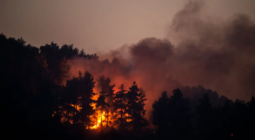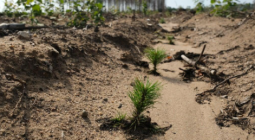Russia forest fire damage worst since records began, says Greenpeace

Analysis shows over 18.16m hectares were destroyed in 2021, an absolute record since satellite monitoring began.
Russia has endured its worst forest fire season in the country’s modern history, according to recent data from the Russian Forestry Agency analysed by Greenpeace.
Fires have destroyed more than 18.16m hectares of Russian forest in 2021, setting an absolute record since the country began monitoring forest fires using satellites in 2001. The previous record was set in 2012, when fires covered 18.11m hectares of forest.
The record was surpassed late last week after a long fire season that has also produced unprecedented levels of global wildfire emissions and upturned daily life for hundreds of thousands of people living in Siberia and elsewhere in central Russia.
“For the past several years, when the area of the fires has surpassed 15m hectares, it has become, in all likelihood, the new normal in the conditions of the new climate reality,” Greenpeace Russia wrote.
Those fires have primarily affected communities in Siberia, where dry, hot summers have turned the vast taiga forests into a tinderbox. In Yakutia, a northern Siberian region that has been particularly hard-hit, smog covered the capital city, Yakutsk, for weeks, and villagers have had to come together in last-ditch efforts to save their homes.
“Emergency workers have come and villagers are also fighting the fires but they can’t put them out, they can’t stop them,” Varvara, a 63-year-old from the remote village of Teryut, said by telephone in July. “Everything is on fire.”
The statistics do not record other types of fires taking place outside Russia’s forests. “If we counted all the fires – grass, reed, tundra, where there is no forest fund – then we would see an even higher number,” wrote Grigory Kuksin, the head of Greenpeace Russia’s firefighting project. The total area could be as high as 30m hectares, he said, an area the size of Italy or Poland.
Burning forests in Russia helped produced some of the worst global emissions in recent months. The Copernicus Atmosphere Monitoring Service of the EU found that burning forests released 1.3 gigatonnes of carbon dioxide last month, the highest since the organisation began measurements in 2003.
The taiga forests of Siberia pumped 970 megatonnes of carbon dioxide into the atmosphere between June and August – more than all the forests in the rest of the world put together. The fires in Yakutia played an important role in that, as the fire season lengthens and pushes farther north, amid unusually high temperatures and lower than normal soil moisture.
According to Greenpeace Russia, the fires in Yakutia are continuing, including north of the Arctic Circle. “That is not characteristic for this time of year,” Kuksin wrote.
Grassfires are also ongoing mainly in Russia’s southern regions of Rostov, Volgograd, Astrakhan and Orenburg, Greenpeace said. Climate change will also make it more difficult for emergency workers to manage Russia’s regular peat fires, which have enveloped Moscow and other cities in noxious smog in past years.
22 September 2021
The Guardian





